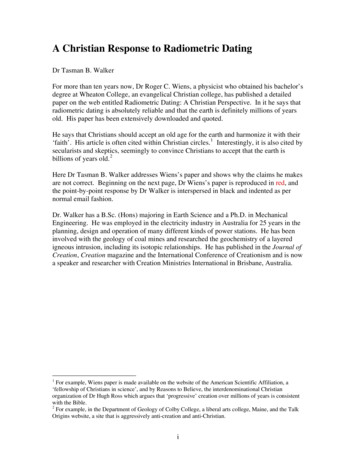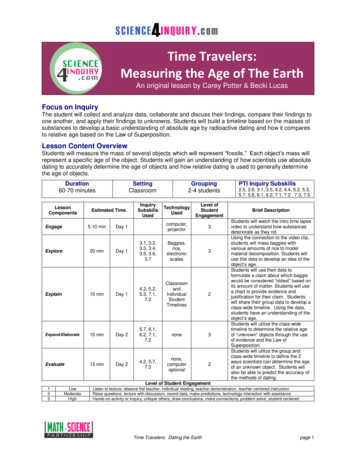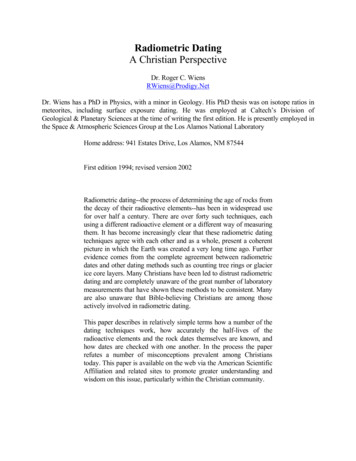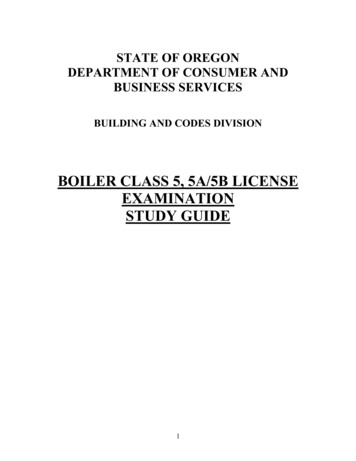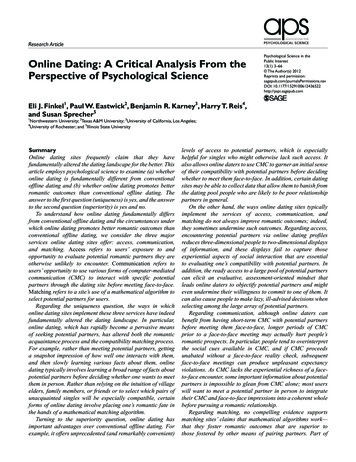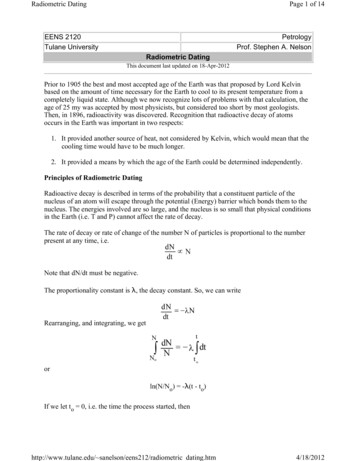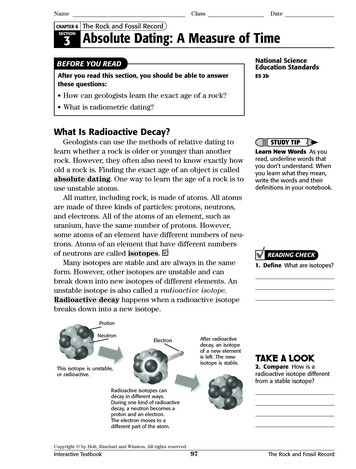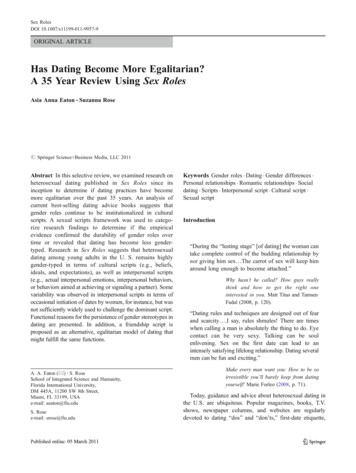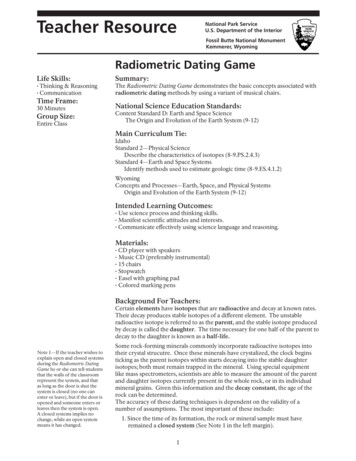
Transcription
Teacher ResourceNational Park ServiceU.S. Department of the InteriorFossil Butte National MonumentKemmerer, WyomingRadiometric Dating GameLife Skills:· Thinking & Reasoning· CommunicationTime Frame:30 MinutesGroup Size:Entire ClassSummary:The Radiometric Dating Game demonstrates the basic concepts associated withradiometric dating methods by using a variant of musical chairs.National Science Education Standards:Content Standard D: Earth and Space ScienceThe Origin and Evolution of the Earth System (9-12)Main Curriculum Tie:IdahoStandard 2—Physical ScienceDescribe the characteristics of isotopes (8-9.PS.2.4.3)Standard 4—Earth and Space SystemsIdentify methods used to estimate geologic time (8-9.ES.4.1.2)WyomingConcepts and Processes—Earth, Space, and Physical SystemsOrigin and Evolution of the Earth System (9-12)Intended Learning Outcomes:· Use science process and thinking skills.· Manifest scientific attitudes and interests.· Communicate effectively using science language and reasoning.Materials:· CD player with speakers· Music CD (preferably instrumental)· 15 chairs· Stopwatch· Easel with graphing pad· Colored marking pensBackground For Teachers:Certain elements have isotopes that are radioactive and decay at known rates.Their decay produces stable isotopes of a different element. The unstableradioactive isotope is referred to as the parent, and the stable isotope producedby decay is called the daughter. The time necessary for one half of the parent todecay to the daughter is known as a half-life.Note 1—If the teacher wishes toexplain open and closed systemsduring the Radiometric DatingGame he or she can tell studentsthat the walls of the classroomrepresent the system, and thatas long as the door is shut thesystem is closed (no one canenter or leave), but if the door isopened and someone enters orleaves then the system is open.A closed systems implies nochange, while an open systemmeans it has changed.Some rock-forming minerals commonly incorporate radioactive isotopes intotheir crystal strucutre. Once these minerals have crystalized, the clock beginsticking as the parent isotopes within starts decaying into the stable daughterisotopes; both must remain trapped in the mineral. Using special equipmentlike mass spectrometers, scientists are able to measure the amount of the parentand daughter isotopes currently present in the whole rock, or in its individualmineral grains. Given this information and the decay constant, the age of therock can be determined.The accuracy of these dating techniques is dependent on the validity of anumber of assumptions. The most important of these include:1. Since the time of its formation, the rock or mineral sample must haveremained a closed system (See Note 1 in the left margin).1
2. The decay constant of the parent isotope must be known accurately andcannot have changed over time for any reason.3. No atoms of the daughter isotope can be present in the rock at its timeof formation (initial daughter).Note 2—The age of the Earthis considered to be equivalentto the age of the solar system,which has been calculated fromthe oldest meteorites at about 4.6billion years. The oldest datedEarth material is a single zirconcrystal from meta-sedimentaryrocks in Australia dated at 4.404billion years old. The oldestrock is the meta-igneous AcastaGneiss of Canada that is dated at4.04 billion years old.Open system or “leaky” behavior, a violation of assumption 1, can occurdue to weathering and alteration, or by heating, burial, and uplift of a rocksubsequent to its formation. Elimination of these factors by careful sampleselection is essential. Assumption 2 is thought to be operative within the Earthsystem and therefore is never violated. Violations of assumption 3 are notuncommon and make accurate dating difficult, but not impossible. There arewell-established methods for calculating the amount of initial daughter presentand applying a correction.The usefulness of a particular isotope pair is dependent upon the naturalabundance of the parent element, and whether the sample contains the parentand daughter isotopes in measurable quantities. Modern mass spectrometersare capable of detecting quantities down to the several parts per billion (ppb)range. The minumum age limit reflects the time necessary for the amount ofdaughter isotope in the sample to reach this level. A maximum age limit isreached when the remaining parent isotope has fallen below the minimumdetection levels. In the case of most long-lived radioisotopes, the maximumdetectable age is 4.6 billion years or the age of the Earth (See Note 2 in the leftmargin).Ultimately the choice of an isotope pair in dating an object is predicated onthe incorporation of the parent element at its time of formation. Thus carbon14 is useful for dating bones, wood and other artifacts that naturally containcarbon. The remaining isotopes are useful for dating igneous and metamorphicrocks, and individual mineral grains from sedimentary rocks. Only the datingof pristine igneous rocks or mineral grains yield an actual “birth date.” Inthe case of metamorphic rocks, the age represents the time of the most recentmetamorphism. Given that most sedimentary rocks are made of fragments ofpre-existing rocks, datable mineral grains in them indicate the age of the originalsource rock, not the sedimentary rock itself. Table 1 (page 2) lists the mostcommonly used isotopes.Most Commonly Used Isotope )N (nitrogen-14)5,730500-60,000Ar (argon-40)1.25 billion100,000-4.6 billionSr (strontium-87)48.8 billion10 million-4.6 billion14 billion10 million-4.6 billionC (carbon-14)1440K (potassium-40)4087Rb (rubidium-87)8714Note 3—Sanidine (potassiumfeldspar) crystals from variousvolcanic ash layers found in theGreen River Formation at FossilButte National Monument havebeen dated using the Potassium40/Argon-40 method and theArgon-40/Argon-39 method (avariation of the Potassium-40/Argon-40 method) yielding datesof 50.2 million years old, and51.7 and 52.2 million years oldrespectively. The most recentpublished date (2008) from theK-spar tuff, a volcanic ash layernear the middle of the GreenRiver Formation is 51.66 /- 0.09million years.DaughterIsotope232Th (thorium-232)208Pb (lead-208)235U (uranium-235)207Pb (lead-207)U (uranium-238)206Pb (lead-206)238703.8 million 10 million-4.6 billion4.47 billion10 million-4.6 billionTable1Fossil Butte National Monument preserves a small portion of an ancient lakeknown as Fossil Lake. The carbonate mud deposited in the lake has becomethe limestone and dolomite of the Green River Formation. The age of thesesedimentary rocks cannot be determined by radiometric dating techniques.2
Fortunately, there are volcanic ash layers known as tuffs interbedded with thelimestone and dolomite (See Note 3 in the left margin).Instructional Procedures:Review concepts: element, isotope, radioactivity, parent, daughter, half-life,and the assumptions of radiometric dating (closed system, constant decay rate,no daughter isotope present at time of formation).You will need a timekeeper/DJ (1), counter/graphers (2), isotopes (16), and chairhandlers (4).Use the following steps to play the radiometric dating game:Note 4—In the RadiometricDating Game chairs are addedto the game of “musical chairs”to provide additional seatingfor newly forming daughterisotopes during each successivehalf-life. The idea is thatbeing seated is a more stableposition(daughter stable)than either standing or moving(parent unstable radioactive).1. Before the game begins the chair handlers will place eight chairs in a singlerow alternating the facing of each chair. Once the chairs are in place, the16 isotopes will arrange themselves in a circle around the chairs and remainstanding. The counter/graphers will verify that the number of daughter(seated 0), and parent (standing 16) isotopes, and record the informationin the game table and plot it on the graphs for time (in half-lives) 0. Once thisis completed, signal the timekeeper/DJ to start the stopwatch and music. Theisotopes will start to walk around the chairs in a clockwise direction. Whenthe stopwatch reaches one minute the timekeeper/DJ will stop the music, andeach parent isotope will attempt to take a seat in the chair nearest them. Byrule there can only be one isotope per chair. The timekeeper/DJ will resetthe stopwatch.2. At this point one half-life has passed. Time is suspended while the counter/graphers verify the number of daughter (8 seated) and parent (8 standing)isotopes, and transfer the information to the table and graphs for time (inhalf-lives) 1. Chair handlers will place four additional chairs (See Note 4 inthe left margin), two at each end of row facing them in alternate directions.When these tasks are completed, signal the timekeeper/DJ to start thestopwatch and music. Those in chairs will remain seated, those standing willbegin to move. After one minute the music will stop and the circling parentswill try to find an empty chair. The timekeeper/DJ will reset the stopwatch.3. At this point a second half-life has passed and time is suspended. Repeat step2 for time (in half-lives) 2. Now their are 12 daughters (seated) and 4 parents(standing). Have the chair handlers place two additional chairs, one atopposite ends of the row.4. At this point a third half-life has passed and time is suspended. Repeat step 2for time (in half-lives) 3. Now there are 14 daughters (seated) and 2 parents(standing). Have a chair handler place one additional chair at the one end ofthe row.5. At this point a fourth half-life has passed and the game is at an end. Have thecounter/graphers verify the number of daughter (15 seated) and parent(1 standing) isotopes, and transfer the information to the table and graphs fortime (in half-lives) 4.See examples of the Radiometric Dating Game table and graphs on pageExtensions:Internet Assignment—Research the age of the Earth online. Have studentsreport on the ages and radiometric dating methods used for a variety of samples(meteorites, Moon rocks, Earth rocks and minerals). Which class of samplesyields the oldest ages? If more than one method was used to date a particularsample, and the dates determined are different have them speculate why thismight be, and whether the difference is significant.3
Assessment Plan:The teacher may select from one of the following assessments, or allow thestudent to chose the one he or she will complete:1. Radiometric Dating Game Student Worksheet—A student master is providedon pages 5-8 and a teacher answer key on pages 9-12.2. Radiometric Dating Game Comic Strip, Graphic Organizer, Song, or Story—Astudent master is provided on page 13 and a grading rubric on page 14.01Time (in half-lives)234Row1Daughter Isotope(in parts per million)08121415Row2Parent Isotope(in parts per million)168421Row3Sum (Row 1 Row 2)1616161616Table 2—Radiometric Dating Game data tableDaughter Isotope(in parts per milliom)161284001234Time(in halfhalf-lives)lives)Graph 1—Radiometric Dating Game daughter isotope abundance graph16Parent Isotope(in parts per million)128400123Time(in half-lives)half lives)Graph 2—Radiometric Dating Game parent isotope abundance graph44
Radiometric Dating Game Student WorksheetName:Date:1. Copy the data from the Radiometric Dating Game data table into Rows 1-3 of the blanktable below. Fill in the empty spaces in Rows 1-3 (Time (in half-lives) 5 and 6) based onyour knowledge of the behavior of parent and daughter isotopes, and the definition of ahalf-life. To complete the remainder of the table follow the instructions below.Time (in half-lives)0Row1Row2Row3Row4Row5Row6123456Daughter Isotope(in parts per million)Parent Isotope(in parts per million)Sum of Isotopes(Row 1 Row2)Parent Isotope(fraction remaining)Parent Isotope(percentage remaining)Daughter-to-ParentRatioRow 4—determine the fraction of parent isotope remaining at time (in half-lives) x, where x 0, 1, 2, 3, 4, 5,or 6 by placing the amount of the parent isotope (Row 2) at time x in the numerator, and the sum ofisotopes (Row 3) at time x, which is equivalent to the initial abundance of the parent isotope, in thedenominator. Simplify your fractions. Show your work.Row 5—calculate the percentage of the parent isotope remaining at time (in half-lives) x, where x 0, 1, 2, 3,4, 5, or 6 by multiplying the value in Row 4 at time x by 100 or by converting the fraction to a decimal andmultiplying by 100. Show your work.Row 6—determine the daughter-to-parent ratio at time (in half-lives) x, where x 0, 1, 2, 3, 4, 5, or 6 bydividing Row 1 by Row 2 for time x. Show your work.5
2. Plot the information in Row 1 on the graph below to show the change in the abundance ofdaughter isotope over time.16Daughter Isotope(in parts per million)128400123456Time(in half-lives)half lives)3. Plot the information in Row 6 on the graph below to show the change in the daughter-toparent ratio over e(in halfhalf-lives)lives)6456
4. Compare the graph of daughter isotope abundance in Problem 2 with the graph ofdaughter-to-parent ratio in Problem 3. Describe the shape of the curves and theirtrajectories. If both graphs contain information about the daughter isotope, thenwhy do they behave so differently?5. In the Radiometric Dating Game the initial abundance of the parent isotope at theformation of our sample was 16 parts per million (ppm). If modern mass spectrometersare capable of accurately measuring isotope abundance down to a level of 10 parts perbillion (ppb), after how many half-lives will it no longer be possible to calculate anaccurate age for the sample? [Hint: At time t 6, the remaining parent isotope equals ¼ppm. There are 1000 ppb in 1 ppm. Calculate the amount of the parent isotoperemaining in ppb for time t x, where x 6, 7, 8, and so on until the quantity remaining isless than 10 ppb.] Show your work.6. The K-spar tuff (volcanic ash) layer near the center of Green River Formation at FossilButte National Monument contains a potassium feldspar mineral, sanidine. A smallfraction of the potassium in sanidine is radioactive potassium-40. Given the amount ofargon-40 (daughter) and potassium-40 (parent) present in the sample today, calculate theage of the K-spar tuff using the graph on the following page.Several sanidine samples have been analyzed in a mass spectrometer and have an averageof 50 parts per billion (ppb) argon-40 (40Ar) and 16,065 ppb potassium-40(40K).The graphical solution uses the ratio of argon-40 to potassium-40. This ratio must beadjusted for the difference in their atomic masses. Because it is useful in this problem towork with large numbers, apply a correction factor of 97,838. Use the following formulato calculate the adjusted daughter-to-parent ratio (D*/P):D*/P 97838D/P,where D* is the daughter isotope, argon-40 in ppb and P is parent isotope, potassium-40in ppb. Show your work.Step 1—Apply the correction factor to the daughter isotope 40Ar.Step 2—Calculate D*/P by dividing the result of Step 1 by the parent isotope 40K and round to thenearest whole number.Step 3—Find the result of Step 2 on the y-axis of the graph and from that point draw a line parallelto the x-axis until it intersects the diagonal line on the graph.Step 4—From the intersection point draw a line parallel to the y-axis until it intersects the x-axis.This new intersection point gives you the age of the sample.7
8(97838 x 00190180170Sample Age (millions of 3632035320343303333032340Potassium-Argon Radiometric Dating GraphEocene Epoch (55.8-33.9 million years ago)
Radiometric Dating Game Student WorksheetName:Date:1. Copy the data from the Radiometric Dating Game data table into Rows 1-3 of the blanktable below. Fill in the empty spaces in Rows 1-3 (Time (in half-lives) 5 and 6) based onyour knowledge of the behavior of parent and daughter isotopes, and the definition of ahalf-life. To complete the remainder of the table follow the instructions below.Time (in half-lives)Row1Row2Row3Row4Row5Row60123456Daughter Isotope(in parts per million)0812141515 1/215 3/4Parent Isotope(in parts per million)1684211/21/4Sum of Isotopes(Row 1 Row2)16161616161616Parent Isotope(fraction remaining)11/21/41/81/161/321/64Parent Isotope(percentage tio0137153.125% 1.5625%3163Row 4—determine the fraction of parent isotope remaining at time (in half-lives) x, where x 0, 1, 2, 3, 4, 5,or 6 by placing the amount of the parent isotope (Row 2) at time x in the numerator, and the initialabundance of the parent isotope (Row 2) at time 0 in the denominator. Simplify your fractions. Showyour work.t 0, 16/16 1t 1, 8/16 1/2t 2, 4/16 1/4t 3, 2/16 1/8t 4, 1/16t 5, (1/2)/16 1/32t 6, (1/4)/16 1/64Row 5—calculate the percentage of the parent isotope remaining at time (in half-lives) x, where x 0, 1, 2, 3,4, 5, or 6 by multiplying the value in Row 4 at time x by 100. Show your work.t 0, 1x100 100%t 1, 1/2x100 50%t 3, 1/8x100 12.5%t 4, 1/16x100 6.25%t 5, 1/32x100 3.125%t 6, 1/64x100 1.5625%t 2, 1/4x100 25%Row 6—determine the daughter-to-parent ratio at time (in half-lives) x, where x 0, 1, 2, 3, 4, 5, or 6 bydividing Row 1 by Row 2 for time x. Show your work.t 0, 0/16 0t 1, 8/8 1t 2, 12/4 3t 3, 14/2 7t 4, 15/1 15t 5, (15 1/2)/(1/2) 31t 6, (15 3/4)/(1/4) 639
2. Plot the information in Row 1 on the graph below to show the change in the abundance ofdaughter isotope over time.16Daughter Isotope(in parts per million)128400123456Time(in halfhalf-lives)lives)3. Plot the information in Row 6 on the graph below to show the change in the daughter-toparent ratio over e(in halfhalf-lives)lives)10456
4. Compare the graph of daughter isotope abundance in Problem 2 with the graph ofdaughter-to-parent ratio in Problem 3. Describe the shape of the curves and theirtrajectories. If both graphs contain information about the daughter isotope, thenwhy do they behave so differently?The curve in the problem 2 graph is convex and rises rapidly early before leveling out. The curve in the problem 3graph is concave and rises slowly at first before ascending rapidly. In the first graph the definition of a half-lifeexplains the rapid change early followed by a leveling out as the abundance of the daughter isotope approaches itsmaximum more slowly. The second graph tracks the ratio of daughter-to-parent, which means small changes early asvalues for the daughter and parent diverge slowly, and rapid changes later as the daughter approaches its maximumand the parent its minimum pushing the value of the ratio towards infinity.5. In the Radiometric Dating Game the initial abundance of the parent isotope at theformation of our sample was 16 parts per million (ppm). If modern mass specrometersare capable of accurately measuring isotopic abundance down to a level of 10 parts perbillion (ppb), after how many half-lives will it no longer be possible to calculate anaccurate age for the sample? [Hint: At time t 6, the remaining parent isotope equals ¼ppm. There are 1000 ppb in 1 ppm. Calculate the amount of the parent isotoperemaining in ppb for time t x, where x 6, 7, 8, and so on until the quantity remaining isless than 10 ppb.] Show your work.At t 6, the remaining parent isotope is 1/4 or 0.25 ppm, which is equivalent to 250 ppb (0.25x1000). Given that witheach half-life, one half of the remaining parent decays it follows that att 7 parent 125 ppbt 10 parent 15.625 ppbt 8 parent 62.5 ppbt 11 parent 7.8125t 9 parent 31.25 ppbSo between 10 and 11 half-lives the amount of the parent isotope will fall below 10 ppb, the minimum detection levelof modern mass spectrometers.6. The K-spar tuff (volcanic ash) layer near the center of the Green River Formation atFossil Butte National Monument contains a potassium feldspar mineral, sanidine. Asmall fraction of the potassium in sanidine is radioactive potassium-40. Given theamount of argon-40 (daughter) and potassium-40 (parent) present in the sample today,calculate the age of the K-spar tuff using the graph below.Several sanidine samples have been analyzed in a mass spectrometer and have an averageof 50 parts per billion (ppb) argon-40 (40Ar) and 16,065 ppb potassium-40 (40K).The graphical solution uses the ratio of argon-40 to potassium-40. This ratio must beadjusted for the difference in their atomic masses. Because it is useful in this problem towork with large numbers, apply a correction factor of 97,838. Use the following formulato calculate the adjusted daughter-to-parent ratio (D*/P):D*/P 97838D/P,where D* is the daughter isotope, argon-40 in ppb and P is parent isotope, potassium-40in ppb. Show your work.Step 1—Apply the correction factor to the daughter isotope 40Ar.Step 2—Calculate D*/P by dividing the result of Step 1 by the parent isotope 40K and round to thenearest whole number.Step 3—Find the result of Step 2 on the y-axis of the graph and from that point draw a line parallelto the x-axis until it intersects the diagonal line on the graph.Step 4—From the intersection point draw a line parallel to the y-axis until it intersects the x-axis.This new intersection point gives you the age of the sample.11
Step 1D* 50 ppb x correction factor 50 ppb x 97838 4,891,900 ppbStep 2D*/P D x 97838/P 4,891,900 ppb / 16,065 ppb 304.5 or 305Potassium-Argon Radiometric Dating GraphEocene Epoch (55.8-33.9 million years ago)32340(97838 x 84950515253545556340330330320320310310Step 3300300290290280280270270260260250250240240Step 3435363738394041424344454647Sample Age (millions of years)484950515251.753545516056The K-spar tuff layer near the center of the Green River Formation at Fossil Butte National Monument was formedapproximately 51.7 million years ago.Teacher’s Note on Problem 5—The following provides a more rigorous mathematical solution:Pt Pi /2t, where Pt is the amount of parent isotope remaining at time (in half-lives) t and Pi is the initial amount of the parent isotope at sampleformation. To solve for t the equation becomes t log2 (Pi /Pt). In the problem, Pi 16 ppm or 16,000 ppb and Pt 10 ppb the minimum detectionlevel of modern mass spectrometers, thereforet log2(16,000/10) log21,600 10.644 half-livesIf it is assumed that the sample is being dated using the potassium-40/argon-40 dating method where a half-life equals 1.25 billion years, thenit would be over 13.3 billion years before the potassium-40 cannot be accurately measured; this is nearly three times the age of the Earth, orabout equal to the age of the universe.Teacher’s Note on Problem 6—40K (potassium-40) decays to both 40Ca (calcium-40, 89.52%) and 40Ar (argon-40, 10.48%). To calculate theage of rocks in the 40K-40Ar system scientists use the following formula:t (1/λ)ln[(40Ar/40K)(λ/ λe) 1], where λ is the decay constant of 40K-40Ca-40Ar system (5.543x10-10/yr and λe is the decay constant for the 40K-40Arsystem (0.581x10-10/yr). And ln is the natural log. The ratio of 40Ar/40K must be adjusted for the difference in atomic weight. The correctionfactor is 0.97838 (39.0983/39.9623).The mathematical solution for problem #3 follows:t (1/5.543x10-10) ln[(50/16065 x 0.97838)(5.543/0.581) 1] (1.804x109) ln[(3.045 x 10-3)(9.540) 1] (1.804x109) ln(1.02905) (1.804x109)(2.864 x 10-2) 5.167x107yrs or 51,670,000 years ago12
Radiometric Dating GameName:Date:Instructions—Write a story, compose a song, prepare a graphic organizer, or draw a comic stripthat describes the Radiometric Dating Game. Your story, song, graphic organizer, or comic stripmust demonstrate an understanding of the scientific concepts and illustrate the changes thatoccurred over time, but gives you the opportunity to be creative.13
Assessment RubricsExcellentGoodThe presentation exhibited UnacceptableNot Attemptedx2x0MultiplierPointsA clear understanding of thefollowing terms: radioactivity,isotope, parent, and daughter.6The incremental changes thatoccurred in the system with time(half-life).6x5x43Logical organization.3Creativity.1Neatness.Attention to detail, i.e. labels, andfew spelling, punctuation, orgrammatical errors.NeedsImprovement114x3
GlossaryAlteration—any physical or chemical change in the mineral composition of a rock.Biotite—a dark-colored tabular mineral of the mica group composed mainly of potassium,iron, magnesium, aluminum and silica; useful in potassium-argon age dating.Carbonate—(a) a mineral that is composed of a metal and the carbonate (CO3-2 ) ion. (b) arock composed of more than 50% carbonate minerals.Closed system—a system in which no matter is allowed to enter or leave.Daughter—a nuclide produced by the disintegration of a radioactive precursor (parent).Decay constant (λ)—a rate proportion relating the change in the amount of a radionuclideto the period of time over which it occurred (dN/dt).Dolomite—a sedimentary rock composed of more than 50% calcium magnesium carbonate.Element—a substance that cannot be broken down into any other substance by chemical orphysical means.Half-life—the time required for one half of a given amount of a radionuclide to decay.Isotope—one of two or more species of the same chemical element having a different atomicmasses because they have different numbers of neutrons.K-spar—short for potassium feldspar, a common rock-forming mineral; K is the symbol forpotassium in the periodic table.Limestone—a sedimentary rock composed of more than 50% calcium carbonate.Metamorphism—the mineral, chemical and physical changes that solid rock undergoes atdepth below the Earth’s surface primarily due to heat, pressure and mineralized fluids.Nuclide—a species of atom characterized by the number of protons and neutrons in itsnucleus.Open system—a system in which matter can enter or escape to the surroundings.Parent—a radioactive nuclide related by its decay to another nuclide (daughter).Pristine—unchanged chemically or physically.Radioactivity—the emission of energetic particles and/or radiation from the nucleus of anatom during radioactive decay.Radiometric dating—determining the absolute age of geologic materials by measuring theparent and daughter isotopic abundance given the known decay rate of the radioactiveparent.Sanidine—a high temperature potassium feldspar mineral characteristics of silica-richvolcanic rocks; useful in potassium-argon age dating.Tuff—consolidated or cemented volcanic ash.Weathering—the physical breakdown, or chemical decomposition of solid rock intofragmentary particles and dissolved ions.15
Radiometric Dating Game Student Worksheet—A student master is provided on pages 5-8 and a teacher answer key on pages 9-12. 2. Radiometric Dating Game Comic Strip, Graphic Organizer, Song, or Story—A student master is provided on page 13 and a grading rubric on page 14. 4 16 12) e llion
